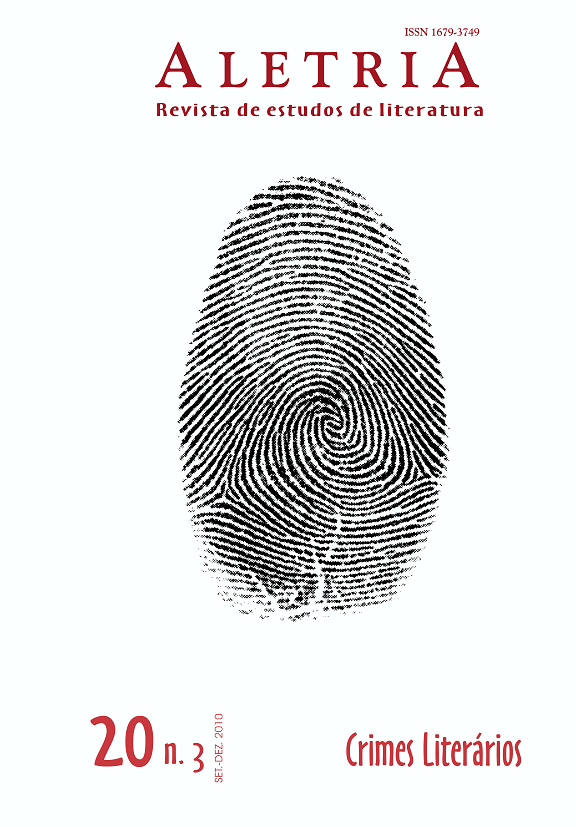Pequenos golpes e astúcias sutis: a figura do trickster na série Blanche white mysteries, de Barbara Neely
DOI:
https://doi.org/10.17851/2317-2096.20.3.159-175Palabras clave:
romance policial, contraliteraturas, periferiaResumen
As práticas cotidianas – especialmente os pequenos golpes e astúcias que caracterizam a figura do trickster – marcam presença na série Blanche white mysteries, de Barbara Neely, objeto de estudo deste artigo. Tomando como base para argumentação a teoria de Michel de Certeau sobre a práxis cotidiana, desenvolvida em A invenção do cotidiano, busca-se discutir de que forma essas práticas se re-significam no embate entre o centro de poder e grupos “invisíveis”, além do seu papel político como uma tática de resistência empregada como oposição a práticas socioculturais dominantes.
Descargas
Citas
CARY, Alice. Grandma just liked to boogie. The Boston Globe, May 9th, 2004. Disponível em: http://www.wumb.org/about/press/Grandmothershands.doc. Acesso em: 23 jul. 2006.
CERTEAU, Michel de (1994). A invenção do cotidiano: 1. Artes de fazer. Trad. Ephraim Ferreira Alves. Petrópolis: Vozes, 2005.
DuBOIS, W. E. B. The souls of black folk. Disponível em: http://www.bartleby.com/114. Acesso em: 8 nov. 2008.
ELLISON, Ralph (1952). Invisible man. New York: Vintage, 1995.
GATES Jr., Henry Louis. The signifying monkey: a theory of African American literary criticism. New York: Oxford UP, 1988.
GOELLER, Allison D. An interview with Barbara Neely. In: MUELLER, Monika; FISCHER- HORNUNG, Dorothea. Sleuthing ethnicity: the detective in multiethnic crime fiction. Madison: Fairleigh Dickinson University Press; London: Associated University Presses, 2003. p. 299-307.
GONZÁLEZ, Mario M. A saga do anti-herói. Estudo sobre o romance picaresco clássico espanhol e algumas de suas correspondências na literatura brasileira. São Paulo: Nova Alexandria, 1994.
GWIN, Minrose. A theory of black women’s texts and white women’s readings, or ... the necessity of being other. NWSA Journal, v. 1, n. 1, p. 21-31, 1988.
HATHAWAY, Rosemary V. The signifyin(g) detective: Barbara Neely’s Blanche White, undercover in plain sight. Critique, v. 46, n. 4, p. 320-332, 2005.
LIBRETTI, Tim. Lucha Corpi and the politics of detective fiction. In: GOSSELIN, Adrienne Johnson (Ed.). Multicultural detective fiction: Murder from the ‘Other’ Side. Ed. Adrienne Johnson Gosselin. [Garland Reference Library of the Humanities, v. 2094]. New York: Garland Publishing, 1998. p. 61-81
LYNE, William. The signifying modernist: Ralph Ellison and the limits of double consciousness. PMLA, v. 107, n. 2, p. 319-330, 1992.
MUELLER, Monika. A Cuban American “Lady Dick” and an African American Miss Marple?: the female detective in the novels of Carolina García-Aguilera and Barbara Neely”. In: MUELLER, Monika; FISCHER-HORNUNG, Dorothea (Ed.). Sleuthing ethnicity: the detective in multiethnic crime fiction. Madison: Fairleigh Dickinson University Press; London: Associated University Presses, 2003. p. 114-132.
NEELY, Barbara. Blanche on the lam. New York: Penguin, 1992.
NEELY, Barbara. Blanche among the talented tenth. New York: Penguin, 1994.
OLDERMAN, Raymond M. Ralph Ellison’s blues and Invisible man. Wisconsin Studies in Contemporary Literature, v. 7, n. 2, p. 142-159, 1966.
PONIATOWSKA, Elena. Mexicanas and chicanas. MELUS, v. 21, n. 3, 1996.
PORTILHO, Carla. Contra-escrituras chicanas: revisitando mitos e subvertendo gêneros. 2004. 100 f. Dissertação (Mestrado em Letras – Literaturas Hispânicas) – Instituto de Letras, Universidade Federal Fluminense, Niterói, 2004.
QUEIROZ, Renato da Silva. O herói trapaceiro: reflexões sobre a figura do trickster. Tempo Social, Rev. Sociol. USP, São Paulo, v. 3, n. 1-2, p. 93-107, 1991. Disponível em: http://www.fflch.usp.br/sociologia/revistas/tempo-social/v3-1e2/queiroz.html. Acesso em: 21 nov. 2006.
REDDY, Maureen T. Traces, codes, and clues: reading race in crime fiction. New Brunswick, N.J.: Rutgers University Press, 2003.
SCHILLER, Beate. Between Afrocentrism and universality: detective fiction by black women. Disponível em: http://opus.kobv.de/ubp/volltexte/2005/547/pdf/schiller.pdf. Acesso em 16 out. 2006.
SOMMER, Doris. Textual conquests: on readerly competence and “minority” literature. Modern Language Quarterly, v. 54, n. 1, p. 141-153, 1993.
TOLSON, Nancy D. The butler didn’t do it, so now they’re blaming the maid: defining a black feminist trickster through the novels of Barbara Neely. South Central Review, Baltimore, v. 18, n. 3/4, p. 72-85, 2001. Número especial: Whose body: recognizing feminist mystery and detective fiction.
WEATE, Jeremy. Changing the joke: invisibility in Merleau-Ponty and Ellison. Philosophia Africana, v. 6. n. 1, p. 5-21, 2003
WITT, Doris. Detecting Bodies: Barbara Neely’s domestic sleuth and the trope of the (in)visible woman. In: BENNETT, Michael; DICKERSON, Vanessa D. (Ed.). Recovering the black female body: self-representations by African American women. New Brunswick, N.J.: Rutgers University Press, p. 165-194.
Descargas
Publicado
Cómo citar
Número
Sección
Licencia
Derechos de autor 2010 Carla Figueiredo Portilho (Autor)

Esta obra está bajo una licencia internacional Creative Commons Atribución 4.0.
Authors who publish with this journal agree to the following terms:Authors retain copyright and grant the journal right of first publication with the work simultaneously licensed under a Creative Commons Attribution Non-Commercial No Derivatives License that allows others to share the work with an acknowledgement of the work's authorship and initial publication in this journal.Authors are able to enter into separate, additional contractual arrangements for the non-exclusive distribution of the journal's published version of the work (e.g., post it to an institutional repository or publish it in a book), with an acknowledgement of its initial publication in this journal.Authors are permitted and encouraged to post their work online (e.g., in institutional repositories or on their website) prior to and during the submission process, as it can lead to productive exchanges, as well as earlier and greater citation of published work (See The Effect of Open Access).





